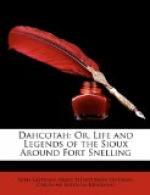CHAPTER III.
We rarely consider the Indian as a member of a family—we associate him with the tomahawk and scalping-knife. But the very strangeness of the customs of the Dahcotahs adds to their interest; and in their mourning they have all the horror of death without an attendant solemnity.
All the agony and grief that a Christian mother feels when she looks for the last time at the form which will so soon moulder in the dust, an Indian mother feels also. The Christian knows that the body will live again; that the life-giving breath of the Eternal will once more re-animate the helpless clay; that the eyes which were brilliant and beautiful in life will again look brightly from the now closed lids—when the dead shall live—when the beloved child shall “rise again.”
The Dahcotah woman has no such hope. Though she believes that the soul will live forever in the “city of spirits,” yet the infant she has nursed at her bosom, the child she loved and tended, the young man whose strength and beauty were her boast, will soon be ashes and dust.
And if she have not the hope of the Christian, neither has she the spirit. For as she cuts off her hair and tears her clothes, throwing them under the scaffold, what joy would it bring to her heart could she hope herself to take the life of the murderer of her son.
Beloved Hail was borne by the Indians to his native village, and the usual ceremonies attending the dead performed, but with more than usual excitement, occasioned by the circumstances of the death of their friend.
The body of a dead Dahcotah is wrapped in cloth or calico, or sometimes put in a box, if one can be obtained, and placed upon a scaffold raised a few feet from the ground. All the relations of the deceased then sit round it for about twenty-four hours; they tear their clothes; run knives through the fleshy parts of their arms, but there is no sacrifice which they can make so great as cutting off their hair.
The men go in mourning by painting themselves black and they do not wash the paint off until they take the scalp of an enemy, or give a medicine-dance.
While they sit round the scaffold, one of the nearest relations commences a doleful crying, when all the others join in, and continue their wailing for some time. Then for awhile their tears are wiped away. After smoking for a short time another of the family commences again, and the others join in. This is continued for a day and night, and then each one goes to his own wigwam.
The Dahcotahs mourned thus for Beloved Hail. In the evening the cries of his wife were heard as she called for her husband, while the rocks and the hills echoed the wail. He will return no more—and who will hunt the deer for his wife and her young children!




